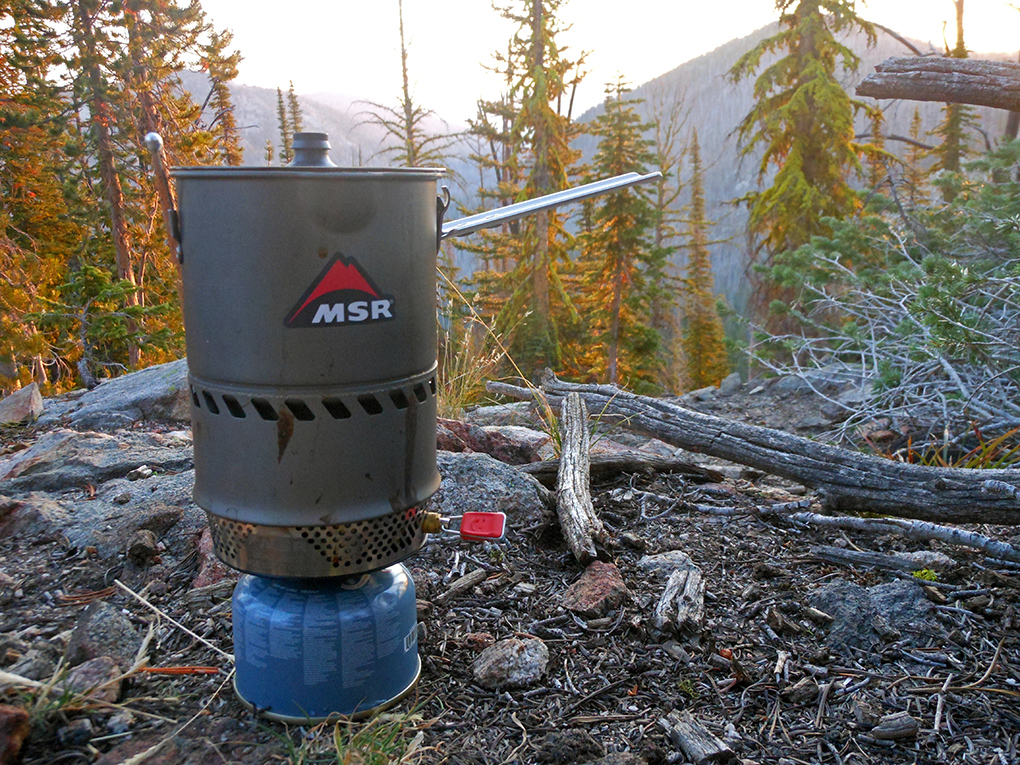Heat Loss / Insulation
Heat loss is another major factor in determining how efficient a stove is. The quicker the system loses heat (relative to the rate at which it is produced), the longer boil times will be. And because the Reactor’s cook pot has no insulation whatsoever, the system dissipates heat easily. While this doesn’t seem to lengthen the Reactor’s boiling times too much, it does make the system more difficult to use for two reasons.
First, the Reactor’s lack of insulation means the pot gets super hot during cooking (too hot hold by hand). MSR added a folding handle on the top of the pot to remedy this, but I didn’t find it to be a very effective solution. The handle is on the very top of the cook pot, so its center of gravity is off-balance, and heavier meals can be difficult to eat unless you wait for the pot to cool down. The Jetboil Sol’s cookpot is wrapped in a thin layer of neoprene insulation that allows you to handle the pot when hot.

Second, being that the Reactor’s naked steel cook pot isn’t insulated, it relies entirely on its heat exchanger to keep its contents warm once hot. I often cook dehydrated meals, adding whatever caloric-dense goop it is I’m slamming down to boiling water.
Cooking dehydrated potatoes using the Reactor, I noticed that my meal would not be as warm (after allowing my potatoes to fully constitute) as I was used to when using my Jetboil Advanced. This may not be a big deal to many people, but after using a Jetboil for so many years, I did notice it.
Weight
The weight and size of my gear matters tremendously to me on self-supported 10-day backpack tours. Combined, the Reactor stove and cook pot tip the scale at a respectable 14.7oz.
This isn’t quite as light as my 10.5oz Jetboil Sol Advanced, or the 8.6oz Sol Ti. ~ 4oz might not sound like a lot, but that’s a quarter-pound, which is something to consider if you’re trying to keep your base-weight to an absolute minimum. To be fair, Jetboil makes less expensive stoves like the Flash that weigh in at 14oz, too.
Of course, none of these weights include the fuel canister. A more efficient stove requires less fuel, and when it comes to bringing water to boil, the Reactor is more efficient than the Jetboil Sol.
Size & Packability
The cooking pot of the Reactor 1L measures 4.75” in diameter, which is slightly more rotund than the Jetboil Sol’s 4” pot, though the Reactor is shorter than the Sol by ½”. These numbers are pretty much a wash for me when it comes to packability. If anything, the Reactor is a little harder to fit in a bear canister, but this is not at all a big deal.
More importantly, both the Reactor cooking system and the Sol are self-contained; their heat exchangers and gas canisters fit neatly inside their cook pots.
MSR redesigned their 4oz IsoPro gas canisters specifically to fit in the Reactor’s cook pot. No other company’s 4oz fuel canister (Jetboil, SnowPeak, etc…) will. You’re out of luck getting the stove and fuel to fit inside the 1L Reactor cook pot unless you buy MSR IsoPro gas.
Jetboil’s cook pots are slightly taller, and they will fit any brand of gas that I’ve come across, including MSR IsoPro.
Price
When it comes to retail price, the $120 Jetboil Sol Advanced is considerably cheaper than the Reactor 1L, which goes for $190. Even the lightened-up Sol Advanced Ti is cheaper than the Reactor 1L, at $150.
Bottom Line
The MSR Reactor’s efficiency and speed comes with a high price tag and some drawbacks. The system cannot be self-contained unless you’re using MSR branded gas, it’s a little on the heavy side, and it has a finicky handle and no insulating layer to make handling the hot cook pot possible otherwise. For these reasons, and given the kind of backcountry cooking I do, I’ll continue to use my Jetboil Sol Advanced.
However, the Reactor 1L stove system performs exactly as MSR says it does. It’s the fastest and most fuel efficient canister stove I’ve used and it works extremely well at high winds and in low temperatures. If you’re going on longer trips and you’re only going to be boiling water / melting snow, I think the Reactor is certainly your best option for a canister stove.

Actually, high altitude improves canister stove performance by increasing the relative fuel pressure. Cold temperatures hurt the performance by virtual of decreased canister pressure, exacerbated by the dropping pressure of the canister further lowering the fuel temperature (ideal gas law).
VanilaGorilla: Personal experience and the lower partial pressure of oxygen at altitude (NOT a lower relative ratio of O2, as commonly misconstrued) would beg to differ with you. If you define performance by gas flow rate then you’re correct, but all stoves I’ve used at altitude, whether alcohol, canister, or white gas, perform worse at altitude than at sea level.